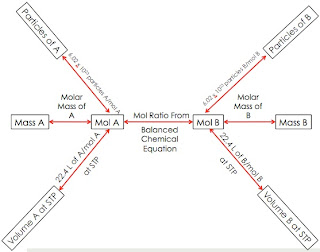- Stamp the homework (4-6 in Reaction solubility and the lab)
- Check homework
- Start Molarity
4.) H2CO3(aq) + 2KOH(aq) ---> 2H2O + K2CO3(s)
5.) CdBr2(aq) + Na2S(aq) ---> CdS(s) + 2NaBr(aq)
6.) 2NaOH(aq) +Ba(NO3)2(aq) ---> 2NaNO3(aq) + Ba(OH)2(aq)
Molarity
M =moles of solute
liters of solution
Its like stoich but there's Liters in it. There are some stuff that Mrs. Mandarino has not covered yet,
she just talked about the equation of Molarity and answered some of the questions in Molarity sheet 1 and 2
Molarity sheet 1
1.)What is the molar mass of the following compounds? Write dissociation reactions for each of them.
(so basically, you just have to find the molar mass- easy)
a.) NaNO3 (1 x 14.01g) + (1 x 22.99g) + (3 x 16.00g) = 85g
b.) CaCl2 (1 x 40.08) + (2 x 35.45g) = 110.48g
2.)Calculate the number of moles of the following (yeah, step by step)
a.) 25g of NaNO3 x 1mol NaNO3 = 294 mol NaNO3
85gNaNO3
b.) 200g of CaCl2 x 1mol CaCl2 =1.8 mol CaCl2
110.98g CaCl2
3.) Calculate the molarity of the following solutions. (You will use the equation in here- new stuff)
a.) 0.25 liters of solution contains 0.0346 moles of NaNO3
M= 0.0346 mol = .1384 mol/L or .138 M
0.250 L
b.) 7.54 liters of solution that contains 0.75 moles of CaCl2
M= 0.75 mol = 15 M
7.54 L
c.) 100.0 ml of solution that contains 1.5 moles of C6H12O6 (Pro tip: watch out for the measurements, we
need liters not milliliters, so it's .1L of solution. Also C6H12O6 is Glucose)
M= 1.5 mol = 15 M
.1 L
d.) 560 ml (.56L) of solution that contains 0.025 moles of AgNO3
M= .02 mol = .036 M
.56 L
Molarity sheet 2
4.) Calculate the molarity of the following solutions.
a.) 1.5 liters of a solution that contains 55.5 g of NaNO3
55.5g NaNO3 x 1 mol NaNO3 = .653 mol NaNO3 (because we want the = .44 M
85.0g NaNO3 1.50L molarity of the solution)
5.) Calculate the moles of solute in the following solution.
a.) 0.2 liters of 0.125 M C6H12O6
.2 L x .125 mol = .025 mol C6H12O6
1L
6.) Calculate the volume of the following solutions.
a.) 0.5 moles of CaCl2 makes of a 0.667 M solution
0.5 mol x L =.750 L CaCl2
.667mol
Well that's all folks. Remember to finish the other questions in Molarity sheet 1 and 2 for homework tomorrow. Furthermore, the webassign are posted and ready to be answered.
